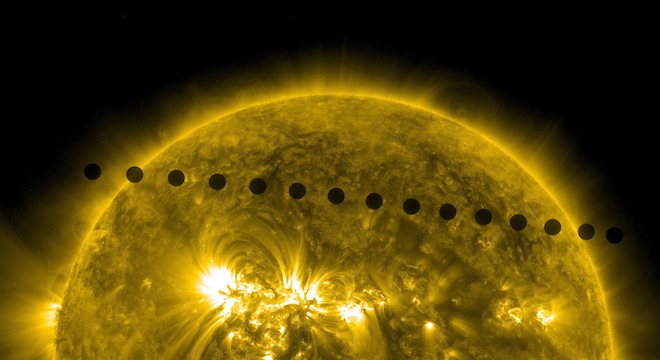Missed the twice-in-a-century occurrence of the planet Venus passing in between the Earth and the Sun on Tuesday? Don’t worry, you won’t have to wait another 105 years to see it again. NASA’s Solar Dynamics Observatory has you covered.
On Wednesday morning, just hours after the six-and-a-half-hour-long event had concluded, NASA published a beautiful video close-up of Venus’s transit in front of the fiery surface of our star.
The video, which shows Venus as a tiny dark spot traveling over the Sun, created by NASA video producer and serial solar artist Scott Wiessinger. It was made up of a compilation of still images captured by the SDO spacecraft in various wavelengths of light and energy invisible to the naked eye, which explains the color differentiation throughout the video.
NASA also published a host of the still images on its SDO website, Flickr, and Google Plus.
The transit of Venus occurs only twice in any given century at most, separated by eight year gaps, which are then further separated by either 105 or 121 years. The odd occurrence is due to the fact Venus’s orbit is tilted three degrees from the plane of the solar system, according to National Geographic.
The event was first observed and recorded in 24 November 1639 by the English astronomer Jeremiah Horrocks, although there are some indications that even more ancient peoples could have seen the event as well. Since the invention of the telescope, it’s only occurred seven times, NASA notes.
This particular transit was supposed to have been visible without a telescope to observers in many parts of the world, including North America, but cloudy weather of course soured the hopes of some.
Although NASA had an opportunity to study the transit in detail eight years ago, in 2004, using another satellite called TRACE, that last occurrence was before the launch of the SDO spacecraft and so this time around, the agency was in an even better position to capture high quality close-ups.
The transit was also helpful to NASA in another way, allowing the agency to better calibrate its SDO spacecraft’s instruments to solar north.
The SDO is both the name of an advanced unmanned spacecraft launched in 2010 that’s now orbiting the Earth, focusing on the Sun, and the NASA mission behind it.






